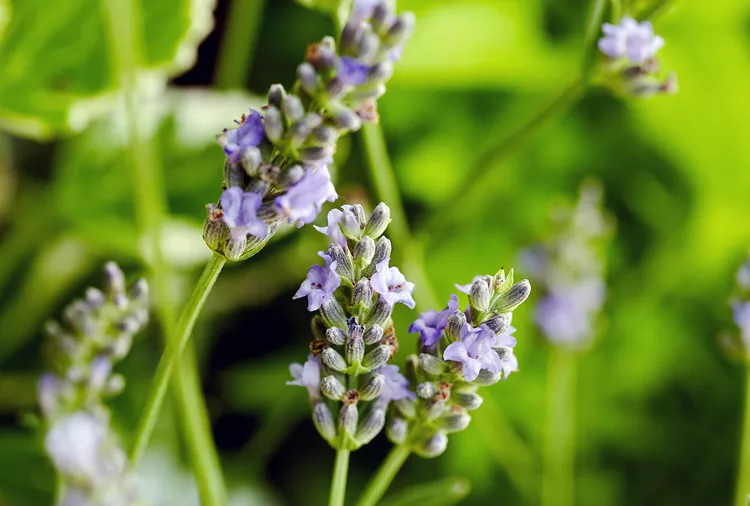Growing lavender plants from seed is a low-cost way to grow lots of this popular herb. And starting seeds indoors before transplanting them outside means you can plant types of lavender that aren’t available at your local garden center. This step-by-step guide will show you how to grow lavender from seed, including must-know techniques for successful germination and growth.
Selecting Lavender Seeds
Choose lavender seeds from catalogs, garden centers, or online retailers that match your climate and plant hardiness zone. You can grow common lavender (Lavandula angustifolia) varieties, such as ‘Hidcote’ and ‘Munstead’. However, seed companies warn customers of variable results when planting seeds gathered from an existing plant. Lavender seeds harvested from a cultivar don’t grow true to variety. Instead, the resulting plants are variations of the parent plant.
If you want a specific lavender plant with a specific bloom color and size, buy lavender plants grown from cuttings from nurseries that do their own propagating or from garden centers that buy plants from local breeders. These cuttings are from an existing parent plant and are rooted to make a new lavender plant.
Preparing the Soil
Gritty or sandy loam with a pH factor of 6.5 to 7.5 is the best soil for growing lavender from seed. Providing seedlings with well-drained soil and full sun will lay a foundation for a beautiful summer display of lavender.
If your soil is more clay-based, grow lavender on mounds. You’ll need to add garden lime to your clay soil to increase its pH level and improve its structure. Most importantly, ensure your ground is free-draining so water doesn’t remain on the lavender plant’s roots for long.
Sowing Lavender Seeds
You can sow lavender seeds indoors anytime, but the best time to sow them if you want to grow the plant outdoors as soon as possible is 8 to 10 weeks before the last frost date in your area. Follow these step-by-step suggestions for sowing lavender seeds indoors.
- Stratify the seeds for three weeks by placing them on a damp paper towel inside a plastic bag in the refrigerator.
- Sow the seeds ⅛ inch deep in flats or small pots containing a soilless mix. Space the seeds about ½ inch apart and cover them lightly with the mix.
- Set the flats or pots in an area indoors with plenty of light, such as on a windowsill, to germinate. Depending on the freshness of the seeds, germination usually begins in 14 to 21 days.
- Water the seedlings and ensure that the soil drains well so that they don’t sit with wet feet for a long time.
The seeds sprout best at 70°F. Some sprouted seeds take up to three months to grow robust roots before they are ready to transplant into a container or garden.
Transplanting Lavender Seedlings
Transplanting outdoors to a garden: To minimize transplant shock, harden off the germinated seedlings by placing them outdoors in a protected spot out of direct sun for about five days before planting them in the garden. Transplant the seedlings into your garden after the last frost date and when the soil has warmed up. Space the plants 2 to 3 feet apart to allow for good air circulation. Plan for your lavender plants to double in size every year for the first three years.
Transplanting to a container: Dwarf L. angustifolia varieties such as ‘Nana Alba’, ‘Blue Cushion’, and ‘Lavenite Petite’ can be transplanted to containers since they have shorter stems and compact foliage. Larger lavenders, such as L. angustifolia ‘Munstead’ and L. angustifolia ‘Hidcote’, can initially be grown in containers but must be transplanted to the garden after two years.
Troubleshooting Common Issues
Lavender doesn't have many major pest problems but root rot and leaf spot, along with some other fungal diseases, can bother this herb.
Fungal Issues
Prevent fungal disease in your lavender plants by making sure the plants don’t retain much moisture. Lavender does not like wet foliage for long periods, so water at the plant’s base with a wand. Watering in the morning rather than the evening gives the sun time to dry the plants’ leaves. Mulching around your plants with a 2-inch cover of white sand or pebbles reflects the sunlight on the plant and speeds up the drying of rain or dew. Leaving space between the plants allows air to flow around them and helps prevent fungus problems.
Root Rot
To prevent root rot, avoid conditions that weaken lavender roots, such as overwatering, poor drainage, insufficient sunlight, and acidic soil. Root rot thrives in slow-draining, dense soil, and it will kill your lavender. If your soil is heavy clay, add grit, pea gravel, and sand to create a quick-draining bed.
Shab
If your lavender plant’s stems turn brown, it might be infected with shab caused by the fungus Phoma lavandulae. Shab is fatal to lavender, so it is best to remove the infected plant before the fungus infects other plants. To avoid spreading disease, clean your gardening clippers or other tools you used on sick lavenders before trimming other plants.




















